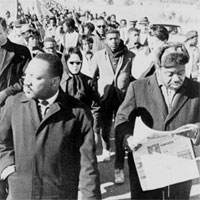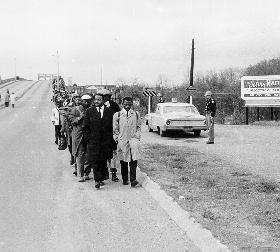Steve Himmer responded to criticism about peace marches, in particular the individual actions of self-expression:
The individual voice in an election doesn’t individually matter. Done. In a march or a rally, on the other hand, that voice can matter–and it can matter without having either the individual voice or the collective subsumed. As 10,000 people march in a street, there is necessarily a unified message–we’re all marching for the same overarching goal, stating our opposition to war, in the current case. At the same time, each of us holds an individualized sign, or wears a uniquely sloganed t-shirt, or a mask, or performs a piece of personally important street theater. While the collective voice of the march can’t be ignored, neither can each individual voice welling up into the collective.
In response, Jonathon wrote of the circumstances in which he would participate in a march:
Recently my friend Natsuko asked me what it would take for me to attend an anti-war march.
‘Everyone would have to agree to wear only plain black clothes,’ I told her. ‘There would be no chanting, no placards, no street theater, no drumming, no red-painted faces. Nothing but hundreds of thousands of black-clad people marching silently through the city.’
Steve responded in comments:
Interesting–the other day, while marching, I wondered at what point what other kinds of mass events were possible, and one of the ideas I considered was a silent river of people flowing don’t the street with signs or chants, without looking left or right. I, too, think it would an incredible piece of street theater, and definitely one worth trying.
 March 7, 1965 600 people began a walk from Selma to Montgomery, Alabama unified behind one goal: voting rights for blacks. These were simple, peaceful people of all ages from all professions and background, with the men primarily dressed in black or gray suits, the women in dresses, white or black, maybe a bit of color with orange or pink or green mixed in. Six blocks later, they were set upon by police who gassed and beat the peaceful crowd as they walked silently through the street.
March 7, 1965 600 people began a walk from Selma to Montgomery, Alabama unified behind one goal: voting rights for blacks. These were simple, peaceful people of all ages from all professions and background, with the men primarily dressed in black or gray suits, the women in dresses, white or black, maybe a bit of color with orange or pink or green mixed in. Six blocks later, they were set upon by police who gassed and beat the peaceful crowd as they walked silently through the street.
There was no screaming at the police, and no thrown rocks, sitting in the street or other acts of civil disobedience. The weapon the marchers carried was more frightening to the authorities of that time – a message of equality.
 However, neither the message nor the marchers would be stopped. Led by Martin Luther King Jr, they marched again two days later, but this time as a means to convince the federal courts to give them explicit permission to march from Selma to Montgomery. The judge granted this permission, and on March 22, 2500 marchers started a walk in Selma, Alabama that would end with 25,000 marchers, five days later in Montgomery, Alabama.
However, neither the message nor the marchers would be stopped. Led by Martin Luther King Jr, they marched again two days later, but this time as a means to convince the federal courts to give them explicit permission to march from Selma to Montgomery. The judge granted this permission, and on March 22, 2500 marchers started a walk in Selma, Alabama that would end with 25,000 marchers, five days later in Montgomery, Alabama.
The photographs and television coverage of the brutality of the police, played against the quiet dignity of the marchers and the simplicity of their unified message, more than any other event, led to the passage of the Voting Rights Act of 1965.
One of the photographers of the march quoted the old African/Quakers proverb to describe it: When you pray, move your feet. To this I add: decide what’s important, and act accordingly.

